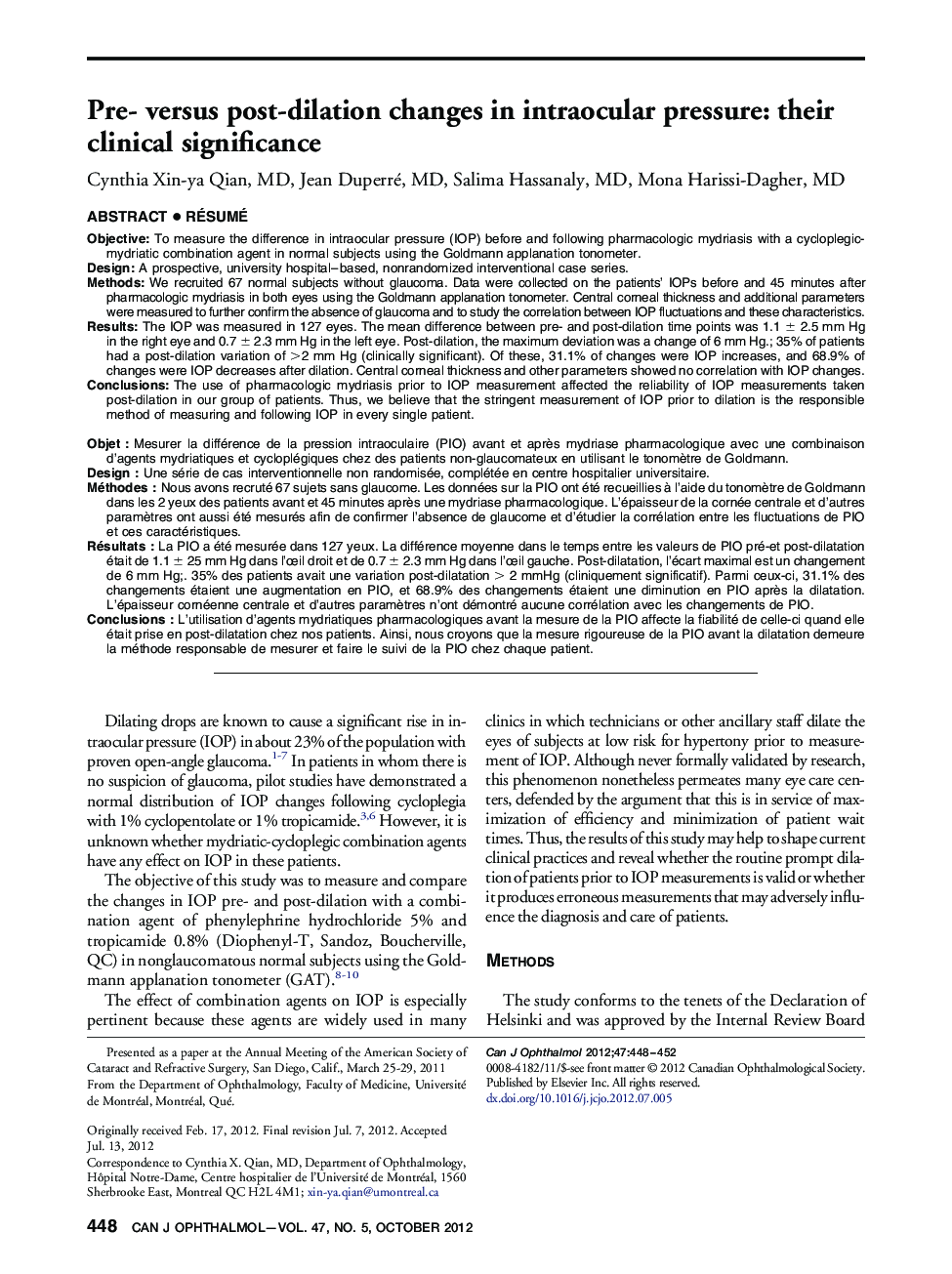| Article ID | Journal | Published Year | Pages | File Type |
|---|---|---|---|---|
| 4009360 | Canadian Journal of Ophthalmology / Journal Canadien d'Ophtalmologie | 2012 | 5 Pages |
ObjectiveTo measure the difference in intraocular pressure (IOP) before and following pharmacologic mydriasis with a cycloplegic-mydriatic combination agent in normal subjects using the Goldmann applanation tonometer.DesignA prospective, university hospital–based, nonrandomized interventional case series.MethodsWe recruited 67 normal subjects without glaucoma. Data were collected on the patients' IOPs before and 45 minutes after pharmacologic mydriasis in both eyes using the Goldmann applanation tonometer. Central corneal thickness and additional parameters were measured to further confirm the absence of glaucoma and to study the correlation between IOP fluctuations and these characteristics.ResultsThe IOP was measured in 127 eyes. The mean difference between pre- and post-dilation time points was 1.1 ± 2.5 mm Hg in the right eye and 0.7 ± 2.3 mm Hg in the left eye. Post-dilation, the maximum deviation was a change of 6 mm Hg.; 35% of patients had a post-dilation variation of >2 mm Hg (clinically significant). Of these, 31.1% of changes were IOP increases, and 68.9% of changes were IOP decreases after dilation. Central corneal thickness and other parameters showed no correlation with IOP changes.ConclusionsThe use of pharmacologic mydriasis prior to IOP measurement affected the reliability of IOP measurements taken post-dilation in our group of patients. Thus, we believe that the stringent measurement of IOP prior to dilation is the responsible method of measuring and following IOP in every single patient.
RésuméObjetMesurer la différence de la pression intraoculaire (PIO) avant et après mydriase pharmacologique avec une combinaison d’agents mydriatiques et cycloplégiques chez des patients non-glaucomateux en utilisant le tonomètre de Goldmann.DesignUne série de cas interventionnelle non randomisée, complétée en centre hospitalier universitaire.MéthodesNous avons recruté 67 sujets sans glaucome. Les données sur la PIO ont été recueillies à l’aide du tonomètre de Goldmann dans les 2 yeux des patients avant et 45 minutes après une mydriase pharmacologique. L’épaisseur de la cornée centrale et d'autres paramètres ont aussi été mesurés afin de confirmer l'absence de glaucome et d'étudier la corrélation entre les fluctuations de PIO et ces caractéristiques.RésultatsLa PIO a été mesurée dans 127 yeux. La différence moyenne dans le temps entre les valeurs de PIO pré-et post-dilatation était de 1.1 ± 25 mm Hg dans l'œil droit et de 0.7 ± 2.3 mm Hg dans l'œil gauche. Post-dilatation, l'écart maximal est un changement de 6 mm Hg;. 35% des patients avait une variation post-dilatation > 2 mmHg (cliniquement significatif). Parmi ceux-ci, 31.1% des changements étaient une augmentation en PIO, et 68.9% des changements étaient une diminution en PIO après la dilatation. L'épaisseur cornéenne centrale et d'autres paramètres n'ont démontré aucune corrélation avec les changements de PIO.ConclusionsL'utilisation d’agents mydriatiques pharmacologiques avant la mesure de la PIO affecte la fiabilité de celle-ci quand elle était prise en post-dilatation chez nos patients. Ainsi, nous croyons que la mesure rigoureuse de la PIO avant la dilatation demeure la méthode responsable de mesurer et faire le suivi de la PIO chez chaque patient.
